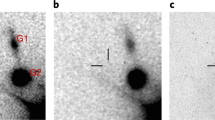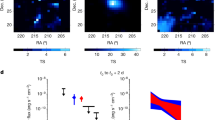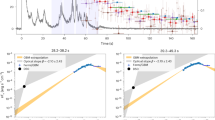Abstract
The binary neutron star merger GW170817 was the first multi-messenger event observed in both gravitational and electromagnetic waves1,2. The electromagnetic signal began approximately two seconds post-merger with a weak, short burst of gamma rays3, which was followed over the next hours and days by the ultraviolet, optical and near-infrared emission from a radioactively powered kilonova4,5,6,7,8,9,10,11. Later, non-thermal rising X-ray and radio emission was observed12,13. The low luminosity of the gamma rays and the rising non-thermal flux from the source at late times could indicate that we are outside the opening angle of the beamed relativistic jet. Alternatively, the emission could be arising from a cocoon of material formed from the interaction between a jet and the merger ejecta13,14,15. Here we present late-time optical detections and deep near-infrared limits on the emission from GW170817 at 110 days post-merger. Our new observations are at odds with expectations of late-time emission from kilonova models, being too bright and blue16,17. Instead, the emission arises from the interaction between the relativistic ejecta of GW170817 and the interstellar medium. We show that this emission matches the expectations of a Gaussian-structured relativistic jet, which would have launched a high-luminosity, short gamma-ray burst to an aligned observer. However, other jet structure or cocoon models can also match current data—the future evolution of the afterglow will directly distinguish the origin of the emission.
This is a preview of subscription content, access via your institution
Access options
Access Nature and 54 other Nature Portfolio journals
Get Nature+, our best-value online-access subscription
$29.99 / 30 days
cancel any time
Subscribe to this journal
Receive 12 digital issues and online access to articles
$119.00 per year
only $9.92 per issue
Buy this article
- Purchase on Springer Link
- Instant access to full article PDF
Prices may be subject to local taxes which are calculated during checkout



Similar content being viewed by others
References
Abbott, B. P. et al. GW170817: observation of gravitational waves from a binary neutron star inspiral. Phys. Rev. Lett. 119, 161101 (2017).
Abbott, B. P. et al. Multi-messenger observations of a binary neutron star merger. Astrophys. J. Lett. 848, L12 (2017).
Abbott, B. P. et al. Gravitational waves and gamma-rays from a binary neutron star merger: GW170817 and GRB 170817A. Astrophys. J. Lett. 848, L13 (2017).
Arcavi, I. et al. Optical emission from a kilonova following a gravitational-wave-detected neutron-star merger. Nature 551, 64–66 (2017).
Coulter, D. A. et al. Swope Supernova Survey 2017a (SSS17a), the optical counterpart to a gravitational wave source. Science 358, 1556–1558 (2017).
Evans, P. A. et al. Swift and NuSTAR observations of GW170817: detection of a blue kilonova. Science 358, 1565–1570 (2017).
Pian, E. et al. Spectroscopic identification of r-process nucleosynthesis in a double neutron-star merger. Nature 551, 67–70 (2017).
Smartt, S. J. et al. A kilonova as the electromagnetic counterpart to a gravitational-wave source. Nature 551, 75–79 (2017).
Soares-Santos, M. et al. The electromagnetic counterpart of the binary neutron star merger LIGO/Virgo GW170817. I. Discovery of the optical counterpart using the dark energy camera. Astrophys. J. Lett. 848, L16 (2017).
Tanvir, N. R. et al. The emergence of a lanthanide-rich kilonova following the merger of two neutron stars. Astrophys. J. Lett. 848, L27 (2017).
Valenti, S. et al. The discovery of the electromagnetic counterpart of GW170817: kilonova AT 2017gfo/DLT17ck. Astrophys. J. Lett. 848, L24 (2017).
Haggard, D. et al. A deep Chandra X-Ray study of neutron star coalescence GW170817. Astrophys. J. Lett. 848, L25 (2017).
Hallinan, G. et al. A radio counterpart to a neutron star merger. Science 358, 1579–1583 (2017).
Mooley, K. P. et al. A mildly relativistic wide-angle outflow in the neutron-star merger event GW170817. Nature 554, 207–210 (2018).
Ruan, J. J., Nynka, M., Haggard, D., Kalogera, V. & Evans, P. Brightening X-Ray emission from GW170817/GRB 170817A: further evidence for an outflow. Astrophys. J. Lett. 853, L4 (2018).
Kasen, D., Metzger, B., Barnes, J., Quataert, E. & Ramirez-Ruiz, E. Origin of the heavy elements in binary neutron-star mergers from a gravitational-wave event. Nature 551, 80–84 (2017).
Waxman, E., Ofek, E., Kushnir, D. & Gal-Yam, A. Constraints on the ejecta of the GW170817 neutron-star merger from its electromagnetic emission. Preprint at https://arxiv.org/abs/1711.09638 (2017).
Rosswog, S. et al. Detectability of compact binary merger macronovae. Class. Quantum Gravity 34, 104001 (2017).
Drout, M. R. et al. Light curves of the neutron star merger GW170817/SSS17a: implications for r-process nucleosynthesis. Science 358, 1570–1574 (2017).
Kumar, P. & Granot, J. The evolution of a structured relativistic jet and gamma-ray burst afterglow light curves. Astrophys. J. 591, 1075–1085 (2003).
Zhang, B., Dai, X., Lloyd-Ronning, N. M. & Mészáros, P. Quasi-universal Gaussian jets: a unified picture for gamma-ray bursts and X-Ray flashes. Astrophys. J. Lett. 601, L119–L122 (2004).
Lamb, G. P. & Kobayashi, S. Electromagnetic counterparts to structured jets from gravitational wave detected mergers. Mon. Not. R. Astron. Soc. 472, 4953–4964 (2017).
Berger, E. Short-duration gamma-ray bursts. Annu. Rev. Astron. Astrophys. 52, 43–105 (2014).
Ruiz, M., Lang, R. N., Paschalidis, V. & Shapiro, S. L. Binary neutron star mergers: a jet engine for short gamma-ray bursts. Astrophys. J. Lett. 824, L6 (2016).
Perego, A. et al. Neutrino-driven winds from neutron star merger remnants. Mon. Not. R. Astron. Soc. 443, 3134–3156 (2014).
Bromberg, O., Nakar, E., Piran, T. & Sari, R. The propagation of relativistic jets in external media. Astrophys. J. 740, 100 (2011).
Lazzati, D. et al. Late time afterglow observations reveal a collimated relativistic jet in the ejecta of the binary neutron star merger GW170817. Preprint at https://arxiv.org/abs/1712.03237 (2017).
Lamb, G. P., Tanaka, M. & Kobayashi, S. Transient survey rates for orphan afterglows from compact merger jets . Mon. Not. R. Astron. Soc. 476, 4435–4441 (2018).
Fong, W. et al. A jet break in the X-Ray light curve of short GRB 111020A: implications for energetics and rates. Astrophys. J. 756, 189 (2012).
Abadie, J. et al. Predictions for the rates of compact binary coalescences observable by ground-based gravitational-wave detectors. Class. Quantum Gravity 27, 173001 (2010).
Granot, J., Guetta, D. & Gill, R. Lessons from the short GRB 170817A: the first gravitational-wave detection of a binary neutron star merger. Astrophys. J. Lett. 850, L24 (2017).
Lamb, G. P. & Kobayashi, S. GRB 170817A as a jet counterpart to gravitational wave trigger GW 170817. Mon. Not. R. Astron. Soc. 478, 733–740 (2018).
Fruchter, A. S. & Hook, R. N. Drizzle: a method for the linear reconstruction of undersampled images. Publ. Astron. Soc. Pac. 114, 144–152 (2002).
Levan, A. J. et al. The environment of the binary neutron star merger GW170817. Astrophys. J. Lett. 848, L28 (2017).
Bertin, E. & Arnouts, S. SExtractor: software for source extraction. Astron. Astrophys. Suppl. Ser. 117, 393–404 (1996).
Schlafly, E. F. & Finkbeiner, D. P. Measuring reddening with Sloan Digital Sky Survey stellar spectra and recalibrating SFD. Astrophys. J. 737, 103 (2011).
Fitzpatrick, E. L. Correcting for the effects of interstellar extinction. Publ. Astron. Soc. Pac. 111, 63–75 (1999).
Alard, C. Image subtraction using a space-varying kernel. Astron. Astrophys. Suppl. Ser. 144, 363–370 (2000).
Foreman-Mackey, D., Hogg, D. W., Lang, D. & Goodman, J. emcee: the MCMC hammer. Publ. Astron. Soc. Pac. 125, 306 (2013).
Gompertz, B. P. et al. The diversity of kilonova emission in short gamma-ray bursts. Preprint at https://arxiv.org/abs/1710.05442 (2017).
Cowperthwaite, P. S. et al. The electromagnetic counterpart of the binary neutron star merger LIGO/Virgo GW170817. II. UV, optical, and near-infrared light curves and comparison to kilonova models. Astrophys. J. Lett. 848, L17 (2017).
Kasliwal, M. M. et al. Illuminating gravitational waves: a concordant picture of photons from a neutron star merger. Science 358, 1559–1565 (2017).
Shappee, B. J. et al. Early spectra of the gravitational wave source GW170817: evolution of a neutron star merger. Science 358, 1574–1578 (2017).
Guillochon, J., Parrent, J., Kelley, L. Z. & Margutti, R. An open catalog for supernova data. Astrophys. J. 835, 64 (2017).
Margutti, R. et al. The electromagnetic counterpart of the binary neutron star merger LIGO/Virgo GW170817. V. Rising X-Ray emission from an off-axis jet. Astrophys. J. Lett. 848, L20 (2017).
Troja, E. et al. The X-ray counterpart to the gravitational-wave event GW170817. Nature 551, 71–74 (2017).
Acknowledgements
Based on observations made with the NASA/European Space Agency Hubble Space Telescope, obtained from the data archive at the Space Telescope Science Institute (STScI). STScI is operated by the Association of Universities for Research in Astronomy, Inc. under NASA contract NAS 5-26555. These observations are associated with programmes GO 14771 (N.R.T.) and GO 14270 (A.J.L.). We thank the staff at STScI for their excellent support of these observations. A.J.L. acknowledges that this project has received funding from the European Research Council (ERC) under the European Union’s Horizon 2020 research and innovation programme (grant agreement no 725246). J.D.L., A.J.L., D.S. and K.W. acknowledge support from the Science and Technology Facilities Council (STFC) via grant ST/P000495/1. N.R.T., P.O., J.P.O., G.P.L., I.M. and S.K. acknowledge support from STFC. G.P.L. acknowledges partial support from the Royal Astronomical Society and International Astronomical Union grants. J.H. was supported by a VILLUM FONDEN Investigator grant (project number 16599). The Cosmic Dawn Center is funded by the Danish National Research Foundation. A.d.U.P., C.C.T. and Z.C. acknowledge support from the Spanish project AYA 2014-58381-P. Z.C. also acknowledges support from the Juan de la Cierva Incorporación fellowship IJCI-2014-21669. M.I. acknowledges the support from the National Research Foundation of Korea grant, No. 2017R1A3A3001362. S.R. has been supported by the Swedish Research Council (VR) under grant number 2016- 03657_3, by the Swedish National Space Board under grant number Dnr. 107/16 and by the research environment grant ‘Gravitational Radiation and Electromagnetic Astrophysical Transients (GREAT)’ funded by the Swedish Research council (VR) under Dnr 2016-06012. P.A.E. acknowledges United Kingdom Space Agency support. D.J.W. is supported by the the Danish Agency for Science, Technology and Innovation under grant number DFF – 7014-00017. G.P.L. thanks A. Higgins and L. Raynard for useful conversations regarding Markov chain Monte Carlo, and G.P.L. and S.K. thank E. Nakar for helpful comments. I.M. thanks J. Granot for useful discussions.
Author information
Authors and Affiliations
Contributions
J.D.L. performed the data reduction and analysis and led writing of the manuscript. G.P.L. performed the numerical calculations and wrote text relating to the model. I.M. contributed to theoretical interpretation of the data and provided analytical estimates. A.J.L. and N.R.T. are principal investigators of the HST proposals used to obtain the new data presented and assisted with data analysis and text. S.K. assisted with the development of the model. B.G. and J.H. contributed to the interpretation of the data and performed the phenomenological fits. A.S.F. and T.K. performed the image subtraction test. All authors provided comments and analysis to assist in the writing of the observing proposals and manuscript.
Corresponding author
Ethics declarations
Competing interests
The authors declare no competing interests.
Additional information
Publisher's note: Springer Nature remains neutral with regard to jurisdictional claims in published maps and institutional affiliations.
Supplementary information
Supplementary Information
Supplementary Figs. 1–2, Supplementary Table 1, Supplementary References 1–42
Rights and permissions
About this article
Cite this article
Lyman, J.D., Lamb, G.P., Levan, A.J. et al. The optical afterglow of the short gamma-ray burst associated with GW170817. Nat Astron 2, 751–754 (2018). https://doi.org/10.1038/s41550-018-0511-3
Received:
Accepted:
Published:
Issue Date:
DOI: https://doi.org/10.1038/s41550-018-0511-3
This article is cited by
-
Rates of compact object coalescences
Living Reviews in Relativity (2022)
-
Gravitational-wave physics and astronomy in the 2020s and 2030s
Nature Reviews Physics (2021)
-
Multi-messenger astrophysics with THESEUS in the 2030s
Experimental Astronomy (2021)
-
Kilonovae
Living Reviews in Relativity (2020)
-
The key role of magnetic fields in binary neutron star mergers
General Relativity and Gravitation (2020)



